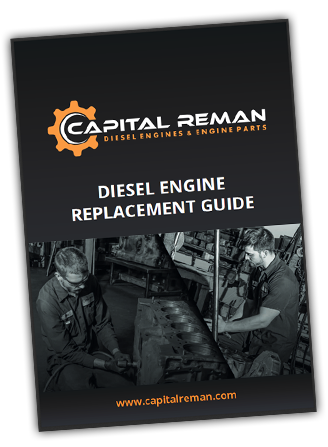Cummins Pioneers 3D Printing Technology to Produce Diesel Engine Parts
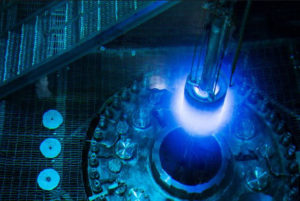 Cummins 3D Printing Process - Image Courtesy Rotey.com
Cummins 3D Printing Process - Image Courtesy Rotey.com
Leading heavy-duty diesel engine manufacturer, Cummins Inc., is pioneering the use of 3D Printing technology to produce and repair critical engine parts. Unlike many manufacturers in the diesel industry, Cummins has its sights on future technology; recently unveiling the first electric engine for semi-trucks. The company believes that in order to thrive in the 21st century it must innovate new technologies rather than adapt to them. Although, 3D Printing is still in its infancy it is becoming more common place for manufacturers due to the potential cost and time to market savings.
Using 3D Printing to Repair Cylinder Heads:
Cummins has partnered with the Department of Energy's Oak Ridge National Laboratory to develop a 3D Printing strategy for the company. The use of 3D printing in automotive parts manufacturing could be huge. Cummins sees the benefits of 3D printing to be 3 fold: making on the fly repairs to worn or damaged engine parts, producing replacement parts as needed and reducing the need for mass production / inventory storage.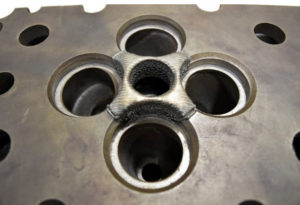 Cummins 3D Printing Cylinder Head Repair - Image Courtesy of Engineering.com
Cummins 3D Printing Cylinder Head Repair - Image Courtesy of Engineering.com
Metallic 3D Printing, also known as, additive manufacturing, works by printing microscopic layers of materials one line at a time to create a desired shape. Initially, the use of 3D Printing can be used to fix existing cracks and damage within engine parts. Cummins is testing the technology to repair cylinder heads. Cracked cylinder heads usually are a death sentence for an engine. Current repair techniques by machine shops are limited to removing the crack and cold stitch welding the hole back together with the use of plugs or heating the cylinder head up to around 900 degrees in an oven, making the weld and then waiting days for the head to cool in a sand pit. Cold stitching provides a temporary patch to prolong the life of the head but does not provide a strong bond between the original casting and the weld. Heat and thaw cycles will eventually crack around the weld. Hot welding or plasma arc welding allows for the weld to be made inside of the oven so that both the weld and casting are broken down on a molecular level and cooled together as one fluid structure. However, the process is time consuming and expensive.
With 3D Printing a traditional milling machine will scoop out the damaged section of the cylinder head. Then researchers will use a CAD file to precisely map out the architecture of the damaged part. The CAD File will then be uploaded into the printer using a G-Code so that filler material can be directly deposited into the damaged area without the use of substrate layer or additional welding.
The 3D Printer Cummins uses is called a DM3D Machine from the company of the same name. The DM3D Machine is a direct energy deposition system which uses a 5-axis CNC head. The spray nozzle is laser guided to get an exact location of the damage. Once the damaged area is detected the nozzle sprays atomized metal power right in the crack and the laser melts the powder layer by layer. Sensors monitor the temperature within the repair to avoid unnecessary cracking of the surrounding cast iron. The technique is very defined and offers a more precise bonding structure with the surrounding metal cast than traditional welding. Eventually, the goal with 3D print repairing is to exactly match the existing metal composition to create a seamless or even stronger cast.
Cummins and Oak Ridge are trying to trying to perfect cast iron repair. Cast iron is prone to cracking under heat and stress. So far the researchers have tested a high-density nickel alloy to avoid metal fatigue during the repair and increase the overall thermal efficiently of the diesel engine part. The results look promising as the bonds under microscopic analysis show good adhesion, however the repaired parts have yet to be tested in real world conditions. Over the coming years Cummins plans to test different metal alloy combinations to determine which alloy creates the strongest chemical bonds to the existing cast iron. The true test will be putting the repaired part through intense heating/cooling cycles during normal engine use.
Printing Parts for Service Departments:
Cummins not only sees a future for 3D printing in its remanufacturing division but also with new parts production. The company predicts a future where each dealer has a 3D printer to print parts in real time as needed. Parts printing would save the company untold amounts of money in mass production of replacement parts as well as storage, shipping and inventory costs. Service departments would have the ability to print replacement parts in a matter of minutes instead of enduring lengthy lead times waiting for shipments. The late 1990s saw the advent of Just-In-Time manufacturing processes, whereas parts would be available at the exact time they are needed in production. 3D Printing would implement just-in-time inventory models from the manufacturer directly to the retail level. Manufacturer and retailer would essentially merge as one unit on some basis.
Pitfalls to Producing 3D Printed Engine Parts:
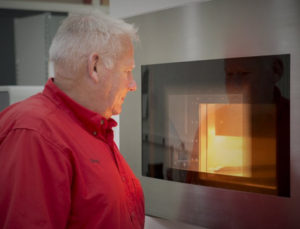 Cummins 3D Printing of Parts - Image Courtesy of Social.Cummins.com
Cummins 3D Printing of Parts - Image Courtesy of Social.Cummins.com
Roger England, Director of Material Science with Cummins, is optimistic yet cautious about 3D Printing. Mr. England believes the technology is still in its infancy and has a long way to go before it is adopted on larger scale. “I think the additive manufacturing industry right now is a lot like the automotive industry around the turn of the 19th century. When folks had cars back in the 1890s or 1900s, it was common that those people were fairly affluent and they could afford to hire a chauffeur who was also a mechanic that could keep the car running.” Mr. England draw parallels to the current environment surrounding 3D Printing citing it is “very labor intensive to keep it running.”
Cummins has complained that 3D Printing Machinery requires a regular stream of software and hardware updates. The technology is going through rapid research and development phases as the manufacturers learn more about how to streamline additive manufacturing. The whole industry is being developed from the ground up and growing pains are commonplace in these early stages. It can be difficult for the end users to learn a new system, adapt to a new interface or upgrade old machinery to accommodate changes in the field.
One of the major hurdles the 3D Printing Industry is learning to overcome is how to develop more robust machinery to meet a continuous workflow. R&D engineers had not anticipated their machinery was going to be used 24 hours a day for months on end. Durability of the internal components currently in place are not rated for a high-output industrial use. Mr. England stated, “The units that we have here are finally getting past the 50 percent uptime availability measure, and that's after we deduct time for scheduled maintenance. It's been a big challenge.”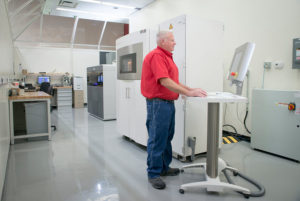 Cummins 3D Printing in Process at Oak Ridge National Lab - Image Courtesy of Social.Cummins.com
Cummins 3D Printing in Process at Oak Ridge National Lab - Image Courtesy of Social.Cummins.com
Other issues surrounding 3D Printing of new engine parts is quality control. Currently, a casting made in any number of Cummins’ facilities worldwide will be held to strict production specifications to ensure the parts are exactly the same no matter where they are forged. With 3D Printing each piece of machinery is so customized that no two are exactly alike. Cummins determined that the level of consistency between parts produced on different machinery is still too great for mass production. The company discovered that an engine part produced on one machine will not exactly match the same part produced on another machine even though the brand, make, model, serial number and user inputs were exactly the same. Mr. England stated, “Until we can get it right every time, it’s not something we’re going to engage.”
However, Cummins sees an immediate use of 3D Printing in prototype development. In the R&D division, creating real world prototypes of parts and engines in a matter of hours is a huge plus for the company. Creating new prototypes of parts requires the creation of plastic molds. With 3D Printing Cummins has produced new injection mold tooling to create complicated designs very quickly. For example the creation of complex cooling passages within various engine parts can be built into the plastic mold much quicker than with traditional methods. Mr. England stated, “A lot of times our volumes aren't great enough to financially justify using injection-molded plastic, because of the cost of amortizing molds. Having now makes plastic injection molding a viable and cost competitive process for lower volumes.”
Positive Environmental Impact:
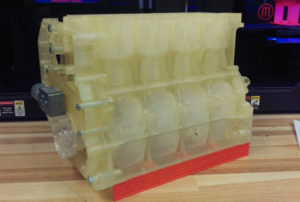 Cummins 3D Model Prototype Engine - Image Courtesy of Fiman Innovations
Cummins 3D Model Prototype Engine - Image Courtesy of Fiman Innovations
In addition to the potential cost savings and shorter lead times, 3D Printing of automotive parts will reduce the environmental impact of manufacturing these parts. Injection-Molded Plastic vs. sand casting aluminum parts reduces the entire carbon footprint through the entire product life-cycle. Currently, engine castings are produced with a consistent metal alloy mixture throughout the part. High-quality material like nickel and chromium are used in mass qualities by Cummins due to their ability to handle high temperatures and pressures. With 3D Printing the ability to only strengthen areas which need higher strength material will cut down on mining costs.
We are living in some exciting times where the limits of technology seem endless. It looks like 3D Printing is on the right track as far as engine parts production goes but time will tell how big an impact on the industry it will have.



